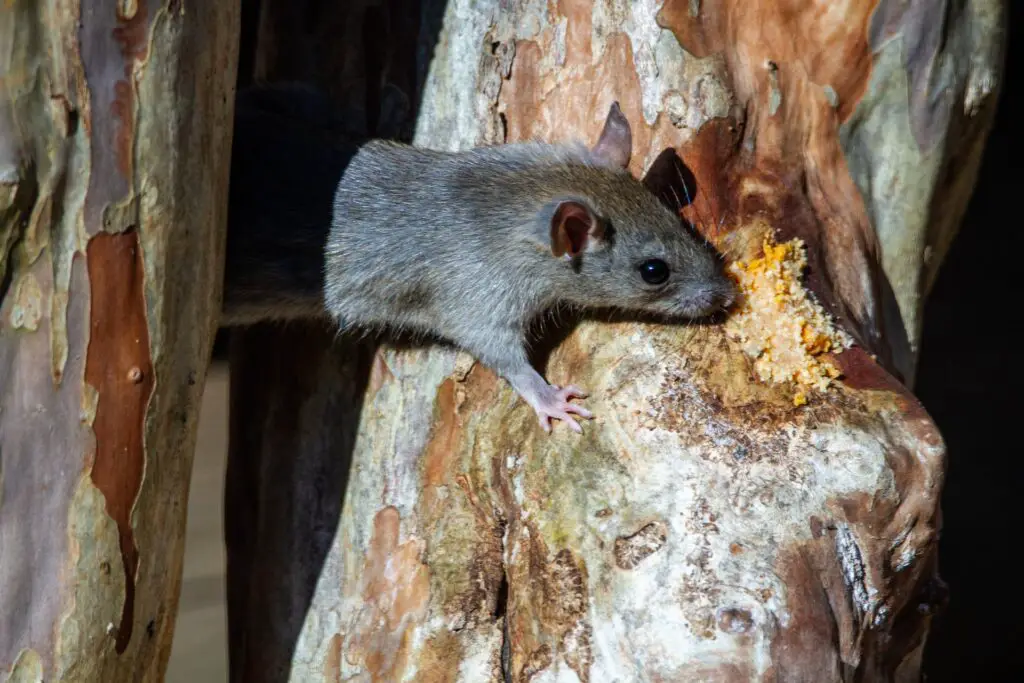Mice are incredibly resourceful creatures, constantly seeking food and shelter. Their ability to find nesting materials and places to hide makes every part of a house appealing to mice, including upper levels. As mice are adept climbers, it’s not uncommon for mice to usually go upstairs in search of fibrous materials such as string to build their nests within walls and ceilings.
These critters use their climbing abilities to gain access through potential entry points found in cracks or gaps. To prevent this, homeowners should store food in airtight containers, clean spills promptly, and consider professional pest control to manage an infestation effectively.
Unveiling Rodent Routines: Do Mice Venture to Upper Floors?
Mice are excellent climbers, which means they do not limit their exploration to the ground floor. Their innate curiosity and search for resources often lead them to venture to upper floors, where they may find less disturbance and more opportunities to secure food and shelter.
The Climbing Abilities of Mice
Mice are relentless in overcoming obstacles and can adeptly navigate vertical spaces. This tenacity, coupled with their small size and flexible bodies, allows them to ascend and explore areas far beyond the ground level.
Can Mice Ascend Stairs Effortlessly?
Given that mice are relentless in pursuit of sustenance and security, they can indeed ascend stairs effortlessly. Their agility and ability to jump enable them to conquer staircases, making it a minor challenge in their quest to explore and colonize new spaces within a home.
The Vertical Limits: Can Mice Scale Walls?
Not only can mice climb stairs, but mice are excellent climbers of vertical surfaces as well. They use their sharp claws to grip tiny crevices and their powerful hind legs to leap upwards, allowing them to scale walls and access various areas within a structure.

Mice Behavioral Patterns
Mice are primarily nocturnal, meaning they are more active at night when searching for food and materials to maintain their nests. Their nighttime activities allow them to avoid predators and move discreetly within a home, often unnoticed by the human occupants.
Signs of a Mouse Infestation in Your Home
Recognizing the signs of a mouse infestation is crucial for timely intervention. Evidence such as mice droppings, gnawing marks, and damage to food packaging can indicate their presence. Mice may seek out upper floors for food and shelter, making ideal nesting spots out of sight.
Telltale Indicators: Droppings and Noises
Mice droppings are a common and unmistakable sign of an infestation. These small, dark pellets are often found along walls, near food sources, and in hidden areas where mice frequent.
Visual Confirmations: Spotting Mice
Seeing a mouse is a definite confirmation of their presence in a home. These sightings can occur when mice are forced to venture out in search of food or if their population has outgrown their hidden living spaces.
Dealing with Unwanted Guests: Mouse Exclusion Strategies
After identifying signs of an infestation, such as mice droppings, homeowners must act swiftly to exclude these unwanted guests. Mouse-proofing homes by sealing entry points and maintaining cleanliness is key to preventing future invasions.
Effective Mouse-Proofing Techniques
Keeping mice out starts with understanding their needs, like nesting materials. By removing these from your home, you eliminate the cozy environment mice seek. Think old fabrics or paper; these are mouse favorites for creating a snug nest. Make sure these materials are stored in sealed containers or disposed of properly to reduce the allure of your home to these furry invaders.
Eradication Measures for Existing Infestations
When mice reach the upper floors, it’s often a sign of a serious infestation. Addressing this involves cutting off their access to food and employing traps or rodenticides. Professional exterminators can help in severe cases, ensuring that the mice are removed thoroughly and safely.
Selecting the Optimal Mouse Bait
Choosing the right bait is crucial in trapping mice. Look for baits that attract mice effectively, such as peanut butter or chocolate. The placement of the bait is also important. Use gloves when handling it to avoid transferring human scent. And keep an eye out for mice droppings, as these can indicate the most frequented paths and best locations for traps.
The Constraints and Effectiveness of Traps
Traps are a common solution, but they come with limitations. Placement is critical—near walls where mice tend to travel. Various trap types exist, each with its own advantages and drawbacks. Some are designed for catch-and-release, while others are lethal. Assess the infestation and consider humane options when possible.
The Persistent Nature of Mice and Recurrence Prevention
Mice are determined creatures, and preventing their return requires a multifaceted approach. It involves sealing entry points, maintaining cleanliness, and using deterrents like ultrasonic devices. Regular monitoring for signs of activity and swift action if mice are detected can help keep your home rodent-free.
Do Mice Abandon a Dwelling on Their Own?
Mice usually don’t leave a cozy home without a reason. If they have shelter, warmth, and food, they’ll stay. To encourage mice from returning, make your home less inviting. This means eliminating food sources, blocking entry points, and maintaining a clean environment. Sometimes, it’s necessary to bring in professionals to ensure mice don’t come back.
The Likelihood of Mice Revisiting Familiar Territories
Mice are creatures of habit and may return to familiar places. If they’ve found shelter or food in your home before, they might try their luck again. Keeping a vigilant eye on potential entry points and maintaining cleanliness is essential to discourage repeat visits.

Nutritional Needs: The Impact of Food Availability on Mice Habitation
Mice are drawn to homes with readily available food. By eliminating access to nourishment, you can greatly diminish the appeal of your space to these rodents. Store grains and cereals in airtight containers, keep fruit in the fridge, and never leave food out overnight. A strict regimen can make all the difference in keeping mice at bay.
What Constitutes a Mouse’s Diet?
A mouse’s diet is diverse, ranging from grains and seeds to fruits and insects. They’re opportunistic feeders and will eat just about anything humans do. This adaptability means that any unsecured food can attract mice, so careful storage and disposal are vital. Check more about this here.
Identifying the Scope of the Problem: Estimating Mouse Population
To tackle a mouse problem, it’s essential to understand its scale. Look for mice droppings, especially in hidden areas, to estimate numbers. Listen for noises within walls or ceilings and check for damage to food packaging. These signs can reveal the presence of mice and hint at the size of the infestation.
How to Gauge the Extent of a Mouse Infestation
Assessing an infestation involves more than spotting a mouse. Search for droppings and grease marks along baseboards, inspect surrounding areas for nests, and listen for activity in the walls. These clues help determine the number of mice and the urgency of control measures. Remember, even a small number of mice can indicate a larger issue.
The Final Verdict: Recognizing the End of a Mouse Infestation
When the scratching sounds cease and mouse droppings no longer appear, homeowners can breathe a sigh of relief, knowing their efforts in mice control are paying off. A lack of fresh droppings is a strong indicator that the mice infestation could be over. However, vigilance is key, as mice can climb walls and exploit poorly sealed windows and doors, meaning a dropping-free environment today doesn’t guarantee a permanent end to rodent troubles.
Observing fewer signs of mice access, such as gaps in brick or concrete where a family of mice could build nests, suggests that the home is no longer a welcoming environment for these pests. Eliminating entry points for mice and maintaining cleanliness, especially around pet food, trash, and compost bins, are critical steps in confirming the end of an infestation.
Securing Professional Assistance in Rodent Control
When the noises coming from ceilings and walls fall silent, it’s time to consider that professional mice control services might have successfully ousted your uninvited guests. Experts in rodent control possess the skills and experience to ensure that every nook and cranny is secure from future invasions, giving homeowners long-term peace of mind.
The Advantages of Enlisting Expert Pest Removal Services
Professionals in pest removal offer more than just eradication; they provide comprehensive strategies for prevention. Their expertise in identifying and sealing entry points, coupled with their knowledge of rodent behavior, ensures a thorough approach to keeping homes mouse-free. This level of service is invaluable for maintaining a healthy and secure household.
Wrapping Up the Mouse Upstairs Dilemma: Insights and Solutions
After exploring how mice climbing abilities can lead to them scurrying upstairs, homeowners can take decisive action to address this common issue. By placing bait like peanut butter in strategic locations, and setting mouse traps with precision, you can effectively capture these nimble creatures. Remember, mice are drawn to homes by the promise of food, so disposing of trash properly and not leaving food out are crucial deterrent practices.
With mouse bait and consistent hygiene, you can create an environment that’s less inviting to these pests with light brown to dusty gray fur and cream or sand-colored underbellies. Tackling the mouse upstairs dilemma requires a multifaceted approach, but with these insights and solutions, a mouse-free home is within reach.

